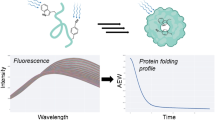Abstract
From the renaturation kinetics of denatured/reduced lysozyme assisted by the molecular chaperone GroEL, a simplified kinetic model was established based on the competition between protein folding and aggregation. In the presence of GroEL and ATP, the aggregate formation was a second order reaction. With 2 mM ATP, a renaturation yield of 90% at a high renaturation rate was obtained when the molar ratio of GroEL to lysozyme was 1:1.
Similar content being viewed by others
References
Dong X-Y, Yang H, Sun Y (1999) Lysozyme reactivation using immobilized molecular chaperonin GroEL. Biotechnol. Tech. 13: 637–641.
Dong X-Y, Yang H, Sun Y (2000) Lysozyme refolding with immobilized GroEL column chromatography, J. Chromatogr. A878: 197–204.
Ellis RJ, van der Vies SM (1991) Molecular chaperones. Annu. Rev. Biochem. 60: 321–347.
Fisher MT (1992) Promotion of the in vitro renaturation of dodecametric glutamine synthetase from Escherichia coli in the presence of GroEL (chaperonin-60) and ATP. Biochemistry 31: 3955–3963.
Guise AD, Chaudhuri JB (1998) Recovery and reuse of the molecular chaperone GroEL for in vitro protein refolding. Biotechnol. Prog. 14: 343–346.
Hevehan DL, De Bernardez Clark E (1997) Oxidative renaturation of lysozyme at high concentrations. Biotechnol. Bioeng. 54: 221–230.
Jenkins AJ, March JB, Oliver IR, Masters M (1986) DNA fragment containing the groE genes can suppress mutations in Escherichia coli dnaA genes. Mol. Gen. Genet. 202: 446–454.
Jeong W, Shin N-K, Shin N-C (1997) Bacterial chaperones increase the production of soluble human TNF-α Escherichia coli. Biotechnol. Lett. 19: 579–582.
Maachupall-Reddy J, Kelley BD, De Bernardez Clark E (1997) Effect of inclusion body contaminants on the oxidative renaturation of hen egg white lysozyme. Biotechnol. Prog. 13: 144–150.
Mendoza JA, Rogers E, Lorimer GH, Horowitz PM (1991) Chaperonins facilitate the in vitro folding of monomeric mitochondrial rhodanase. J. Biol. Chem. 266: 13044–13049.
Rozema D, Gellman SH (1996) Artificial chaperone-assisted refolding of denatured-reduced lysozyme: modulation of the competition between renaturation and aggregation. Biochemistry 35: 15760–15771.
Teshima T, Kondo A, Fukuda H (1997) Reactivation of thermally inactivated enzymes by free and immobilized chaperonin GroEL/ES. Appl. Microbiol. Biotechnol. 48: 41–46.
Tsurupa GP, Ikura T, Makio T, Kuwajima K (1998) Refolding kinetics of staphylococcal nuclease and its mutants in the presence of the chaperonin GroEL. J. Mol. Biol. 277: 733–745.
Author information
Authors and Affiliations
Corresponding author
Rights and permissions
About this article
Cite this article
Dong, XY., Wang, YB., Liu, XG. et al. Kinetic model of lysozyme renaturation with the molecular chaperone GroEL. Biotechnology Letters 23, 1165–1169 (2001). https://doi.org/10.1023/A:1010504824604
Issue Date:
DOI: https://doi.org/10.1023/A:1010504824604




